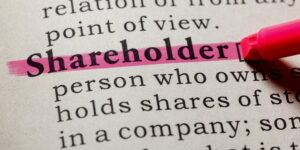Profits made by companies limited by shares are often distributed to their members (shareholders) in the form of cash dividend payments. Dividends are issued to all members whose shares provide dividend rights, which most do.
Company profits are distributed in proportion to the percentage of shares held by each member. These distributions are often described in terms of:
- the dividend rate – the actual amount that is paid out in respect of each share (e.g. £1)
- the dividend yield – the dividend rate paid out per share, expressed as a percentage of the current stock value (e.g. if the dividend rate was £1 but the market value of each share is £50, then the dividend yield is 2%)
Dividend payments do not always comprise the entire profit of an organisation. Many companies will decide to re-invest a portion of their profit in the business. This is known as ‘retained earnings’.
- Transfer shares in your company today
- Dividend tax guide with calculator 2024-25
- Would you like a company secretary for your business – but think you can’t afford it?
Companies cannot count dividends as business expenses when calculating Corporation Tax.
Furthermore, they are not allowed to pay out any more in dividends than is available from profits already accumulated and eligible for this purpose. These available profits are known as ‘distributable reserves’ or ‘distributable profits’.
What is the procedure for paying dividends?
Broadly speaking, there are two forms of dividends: final dividends and interim dividends. Below we will consider the general rules that apply to the payment of both types of dividends, as well as make the distinction between interim and final dividends.
General rules
Company directors should hold a board meeting and agree to ‘declare’ a dividend (either themselves or subject to approval by the members). Minutes of the meeting must be kept, even in the case of a sole director.
A dividend ‘voucher’ must be created for each dividend payment, and the following information should appear on the voucher:
- date of dividend payment
- amount of the dividend
- name of company
- names of shareholders eligible to receive a portion of the dividend payment
A copy of this dividend voucher must be provided to each shareholder eligible to receive a portion of the dividend, and a further copy should be retained for company records.
The rules for issuing and paying dividends can vary from company to company. Any specific company procedures should be stated in the articles of association.
A free dividend voucher template is available from 1st Formations.
Final dividends
Final dividends are issued on the basis of profits for the fiscal year.
Directors will make a recommendation as to the amount of dividend, but they must seek approval from the members at a general meeting or via a written resolution. At this point, the shareholders can decide to reduce the level of dividend payment, but they cannot declare a higher amount.
Once a final dividend payment has been declared/approved, the company is obliged to pay this.
Interim dividends
Interim dividends can be paid out at any time during the course of the financial year.
Subject to any restrictions in the articles of association, this form of dividend can be declared by directors without any need to gain approval from shareholders.
Any decision to pay an interim dividend must be on the basis of relevant interim accounts which should be filed with Companies House.
If an interim dividend has been declared by the directors alone, there is no obligation to actually pay it. The board can change its decision if circumstances change.
Dividend Tax Calculator
What are the duties of directors when declaring dividends?
As per section 174 of the Companies Act 2006, a company director “must exercise reasonable care, skill and diligence” and, in accordance with s 172, “must act in the way he considers, in good faith, would be most likely to promote the success of the company for the benefit of its members as a whole”.
When deciding whether to recommend a dividend payment, directors need to have regard to these duties, and others contained in the relevant part of the Companies Act 2006.
As such, they should first ensure they fully understand the rules surrounding dividend payments and carefully assess the financial position of the company to determine whether the level of dividend payments is appropriate.
- How to take money out of a limited company
- Set up a limited company with our All-Inclusive Package
- A guide to company shares
Not only must dividend payments fall within the limits of available distributable reserves, but they should also take into account the overall position of the company to meet its debts. Directors who authorise dividend payments for which there are insufficient distributable profits* are personally liable for any consequent shortfalls.
They can also be held liable if a dividend is paid when the company is insolvent or if they should have reasonably foreseen cash flow problems.
* Section 830 of the Companies Act 2006 states that: “A company may only make a distribution out of profits available for the purpose” which consists of “its accumulated, realised profits, so far as not previously utilised by distribution or capitalisation, less its accumulated, realised losses, so far as not previously written off in a reduction or reorganisation of capital duly made.”
Technical guidance on distributable profits under the Companies Act is available from the Institute of Chartered Accountants in England and Wales (ICAEW).
How are dividends paid?
Dividends were traditionally paid via cheque, but now it is more common for payments to be made using direct bank transfer – although there will normally be a choice for the shareholders. The methods of payment available will generally be stipulated in the articles of association.
Sometimes dividends will be paid in the form of additional shares. This is known as a scrip dividend. Often there will be an option for members to receive a dividend either in the form of cash or additional shares.
One of the benefits of opting for a scrip dividend is that transaction costs (i.e. purchasing new shares) can be avoided. However, there is no tax advantage because scrip dividends are treated in the same way as cash dividends for purposes of taxation.
Dividend payments have a tax-free allowance of £500 (applicable to the 2024/25 tax year). After this, they are taxed according to the shareholder’s Income Tax band:
- 8.75% at the basic rate
- 33.75% at the higher rate
- 39.35% at the additional rate
GOV.UK provides more information about tax on dividends and the latest rates.
It is worth mentioning that some companies also offer dividend reinvestment plans (DRIPs) that provide members with more shares instead of cash. However, there are some important technical differences between drip and scrip dividends.
Multiple classes of shares and dividends
Some companies offer different classes of shares for the purpose of organising a specific distribution of dividend payments. For example:
- Ordinary shares – these may be separated into alphabet classes, each assigned a letter to differentiate them (e.g. “A” ordinary shares, “B” ordinary shares etc) – a different dividend rate can then be applied to each of these classes of alphabet shares.
- Preference shares – these have a fixed rate of dividend which is paid out before the other share classes, meaning that they take precedence over ordinary share dividends. Any remaining sums available for distribution are shared between the holders of ordinary shares after preference shareholders have been paid.
- Cumulative preference shares – these are similar to preference shares, but they provide that, if a dividend payment is missed or not paid in full (e.g. as a result of insufficient distributable profits), the shareholder will receive any shortfall in a future dividend payment when there are sufficient distributable reserves.
- Deferred ordinary shares – holders of these types of shares will not receive any dividend payment until holders of the other shares have received a minimum dividend, after which they will receive the same rate of dividend as other shareholders.
- Non-dividend paying shares – there may be instances where a specific class of share that excludes its holders from entitlement to any dividend payments is required.
Any decision to create new classes of shares to distinguish dividend rights should be approved at a board meeting with an ordinary resolution. Minutes of the meeting should reflect the approval and be filed accordingly.
The articles of association should also be amended if necessary (e.g. if they do not permit the creation of new classes of shares).
Dividend waivers
There are occasions when a shareholder may choose to not accept a dividend payment; this is known as a dividend waiver.
The reason for waiving a dividend may be because it is preferable to keep money in the company and re-invest this in running the business, compared to receiving payment and losing some of the profit through the consequent taxation of dividends, etc.
A Deed of Waiver should be used to give effect to a dividend waiver. In the case of final dividends, the waiver should be put in place prior to the dividend being declared; in the case of interim dividends, the waiver should be set up before payment.









Join The Discussion
Comments (6)
in a case of where five of us are shareholders but 2 are dormant , they do not participate in any company activities in any form, if it is the point of sharing the dividends, must we share equally or something.
Thank you for your kind enquiry, Ayuel.
In general terms, unless the shares held by the 2 “dormant” shareholders belong to a different class which has different dividend rights to those shares held by the other shareholders, you would normally expect equal treatment as regards the payment of dividend (in other words, the 2 “dormant shareholders” should receive the same amount of dividend per share as the other shareholders). This is because all shares of the same class must be treated equally to one another. If this is not a situation you want, you may want to look at introducing multiple share classes.
We trust this information is of use to you.
Kind regards,
The 1st Formations Team
I have a percentage of shares in a limited company that have typically been paid by a. monthly dividend payment on profit earned after corporation tax is deducted this has been the case for 10+ years.
I have now been told by the company’s owner and main shareholder that he is going to withhold dividend payment’s even though the company is making a profit.
I own shares in the business, Is this correct?
Thank you for your kind enquiry.
As a general rule, there’s no strict requirement that profit has to be paid to the shareholders of the company. Oftentimes, profit might be kept within the company, for example for the purposes of reinvesting in the company’s operations. This is called retained earnings. Further, it should be noted that it is for the directors to determine whether a company can declare a dividend (after all, they are normally liable, if the company pays a dividend it should not have). So, in a strict sense it is not incorrect to say that company might decide not to pay a dividend, although this is of course subject to the articles of association, and any shareholder agreements in place, etc.
We trust this information is of use to you.
Kind regards,
The 1st Formations Team
I have just been paid an interim dividend. However it was close to six weeks after the announcement, and five weeks after the first person received their payment.
Some were paid by cheque and some by BACS but this was done over a period of five weeks, ie we were not all paid at the same time
you may or may not be able to help me but thanks for taking the time to read this
J DAVIES
Thank you for your kind enquiry, John.
Generally speaking, shareholders may have a preference as to how they receive their dividends, so it’s not uncommon for some shareholders to receive payment in one form and other to receive payment in another. For example, the model articles of association state that any dividend must be paid by a bank transfer, cheque, or another means as agreed by the directors (or a combination of any of these).
As regards the timescales of the payment, we are not aware of a specific timetable in which companies must pay their dividends. However, we would expect shareholders to be paid at the same time. It is not usually possible to vary the payment terms between shareholders unless a share structure is put in place that permits this variability – for example, multiple share classes.
We trust this information is of use to you.
Kind regards,
The 1st Formations Team